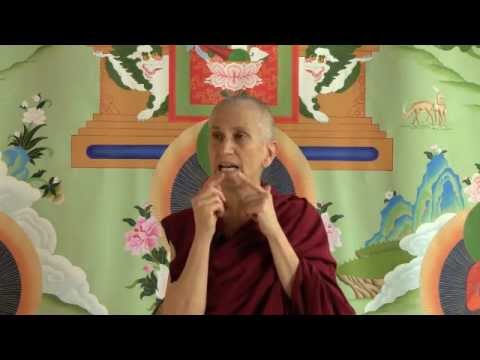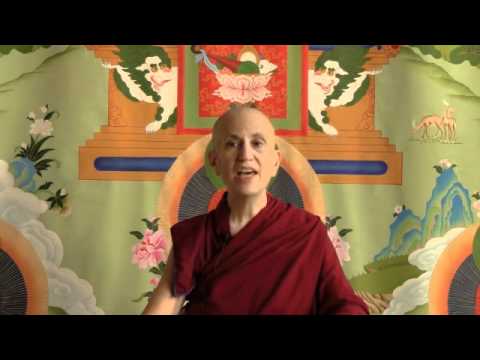The four immeasurables
This talk was given during the White Tara Winter Retreat at Sravasti Abbey.
- What makes these qualities “immeasurable”
- The causes of happiness and the causes of suffering
- How our minds tend to be very biased and how we categorize people
White Tara Retreat 11: Four immeasurables (download)
Let’s continue with the sadhana. After we take refuge and generate bodhicitta, then come the verses of the four immeasurables. What we have there is the short version of the four immeasurables; there is also a longer version you can use, if you wish, in your meditation.
Immeasurable love
It starts out, “May all sentient beings have happiness and its causes.” That is immeasurable love. It is called immeasurable because it extends to countless, or immeasurable, sentient beings; and it is called immeasurable because you develop it to a limitless degree. By the way, when we talk about sentient beings, it indicates any being with a mind except for Buddhas. Buddhas are not sentient beings. But it can go from very small creatures up to human beings. It doesn’t include plants; they are said to be biologically alive but without consciousness. Please don’t send me a lot of questions asking me why not; you can look at one of my books about that.
Love, the first one: the definition of love is to wish happiness and its causes. It is not just happiness; it is also the causes of happiness. It really makes us think, what is happiness? We think happiness is getting everything we want, but think about that again. Is that real happiness? Getting everything you want?
Immeasurable compassion
The second one is, “May all sentient beings be free of suffering and its causes.” There, suffering means any undesirable experience. It doesn’t mean just physical or mental pain, but just the fact of having a body and mind under the influence of afflictions and karma is undesirable or unsatisfactory. So wanting sentient beings to be free of that is compassion. So, again, to be free of suffering. The Sanskrit and Pali word is dukkha: unsatisfactory experiences and their causes. It makes us think, what is an unsatisfactory experience and what causes them?
This is the big thing we are ignorant about: what are the causes of happiness and what are the causes of misery? We think we know, but we are actually quite ignorant about that. We do lots of things trying to be happy, and we get misery instead, don’t we? This happens all the time. And yet, we still do the same old things thinking they’re going to bring us happiness the next time, and yet they still bring us misery. Sometimes we do things that we think are going to make us miserable, but they actually make us happy. My mother and father made me do all sorts of things when I was a kid that I didn’t want to do, and they said, “Just do it, try it, and you’ll be happy. I didn’t want to do those things. Actually my parents were right; I had great fun. But they didn’t understand about Dharma. That is the real thing that brings happiness.
Immeasurable sympathetic joy
The third immeasurable is, “May all sentient beings never be separated from sorrowless bliss.” Here sorrowless bliss can refer to a good rebirth while we are still in cyclic existence or the real sorrowless bliss is the bliss of liberation when we are free of taking rebirth under the influence of afflictions and karma. Wishing that is immeasurable joy.
Immeasurable equanimity
The fourth one is, “May all sentient beings abide in equanimity, free of bias, attachment and anger.” Equanimity is a mind that is free of attachment to friends, anger, dislike of other people and apathy toward strangers. It is a mind of equal-hearted openness toward everybody.
Those are the four immeasurables, and I’d like to talk about them in a little more depth because they’re quite important for working with a lot of the problems we have in relating to other people.
Our mind tends to be very biased, as it says in the last one, “to be free of bias, attachment and anger.” We tend to be so biased. People who are nice to me, who like me, who agree with me, and those who give me things—or give me things that I want—those are the friends that I love and I’m attached to and that I never want to be separated from. People who criticize me, who get in my way, who don’t agree with my ideas, who find faults and give me things that I don’t want: those people are enemies and I have a lot of hatred and aversion towards them. Everybody else who doesn’t interact with me in one way or another, they’re just…nothing. I don’t care about them. It is almost as if they don’t have feelings.
We get caught up in these three feelings of attachment, aversion, and apathy in relationships to the three groups of people: friends, enemies, and strangers. We get stuck in a lot of quite difficult situations and become like an emotional yoyo according to how we view these three groups of people. Yet it’s basically our own mind that makes somebody into a friend, an enemy, or a stranger based on how they treat me. Because I’m the center of the universe, right? I’m glad you agree!
We will go into a little bit more depth with these immeasurables in the upcoming talks. In the meantime, just observe how your mind categorizes people into friends, enemies, and strangers based on how they relate to you—the center of the universe. Or, how they relate to other people or things that are important to you as the center of the universe. Just observe how that happens. How you categorize people. How you then generate the three emotions: the attachment, aversion, and apathy. Then, what happens after that? How you act toward these three groups of people. What are the results of your actions on yourself and on others?
Do a little bit of research on that, on how the system is working now, and that will help us see the flawed way of thinking and then that will open our mind to what to look at in a different way.
Venerable Thubten Chodron
Venerable Chodron emphasizes the practical application of Buddha’s teachings in our daily lives and is especially skilled at explaining them in ways easily understood and practiced by Westerners. She is well known for her warm, humorous, and lucid teachings. She was ordained as a Buddhist nun in 1977 by Kyabje Ling Rinpoche in Dharamsala, India, and in 1986 she received bhikshuni (full) ordination in Taiwan. Read her full bio.


